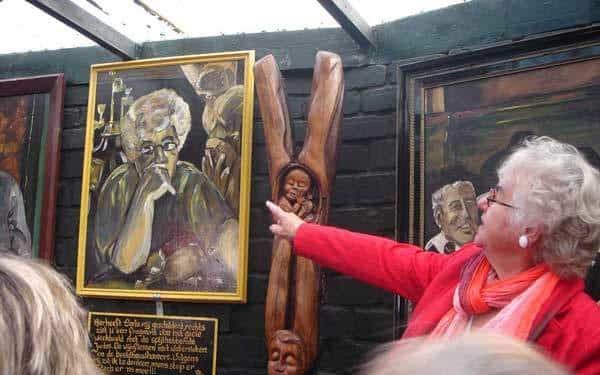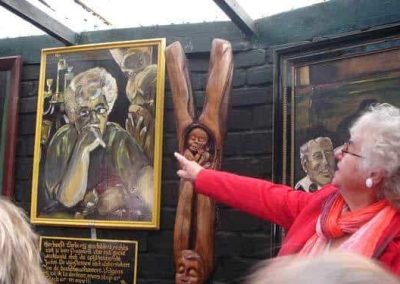The noble house is a mix of the efteling, gnome land and alice in wonderland in a museum form. You really have too many eyes to take it all in. Afie is an extraordinary woman, she has a lot of zest for life and humor and loves to tell about her “noble house.” Afie and her Nobel house you don’t easily forget and keep yes after visit good memories. The museum is located on the edge of the dunes in Egmond Binnen and thus has a self-built mini museum, small chapel, several workshops, a vegetable garden, orchard and chicken land.
You do have to call for an appointment before you can go in. she’ll give you a tour and who knows, she might even let you taste some of her homemade wine.
Mini museum & chapel
Afra Valkering -Zentveld (1939), or Afie is one of Egmond-Binnen’s most extraordinary artists and a bon vivant.
Nor is it surprising that she has already been featured on television program Man bites Dog. The museum that developed over a course of years next to her own home. Handwritten explanations and aphorisms hang on the wall.
The chapel is open daily. Afie gives tours upon request. An extraordinary experience!
Workshops
Afie’s 2 daughters Ria and Carla Laroo give workshops and courses in pottery and painting in their studios on the Mooyeveld.
Afie’s Nobel House
Mooyeveld 4a
Egmond-Binnen
Phone: 072-5061841
We end up at the Nobel House, an Efteling house made of cake; that’s what it looks like. This is the domicile of Afie Valkering (19???; about 75 years young); it is home, studio and museum in one. Afie paints, makes candle wax sculptures and crafts beautiful, colorful reliefs in wood. Most of her oeuvre is exhibited in the garden and a few sheds.
She welcomes us in a cozy living room, where we are seated at a long table. The glasses are ready, but first we listen to her life story. Her career began in a “skeer store” (men’s hair salon), but then she met the man of her life, whom she always calls “My Theo. They were able to buy this cottage. The previous owner was a professor (“I don’t even know wherein, but I think it was something with languages, so I added something in French”).
Afie speaks with the tongue of the mind, of which the “sk” is the most prominent feature. You shouldn’t think, they can’t pronounce “sch” here. If you ask a born Heemskerker where he was born, he will answer, “Heemscherk.
Afie had two daughters, who also became visual artists. Below you can see her with a portrait painted by one of her daughters. In addition, an anti-abortion view; Afie abhors abortion – as she abhors anything to do with death.
1992 was a disaster year. Theo died suddenly of a heart attack. He had gone to pick some flowers, and was found dead, holding seven daffodils. Afie fondly remembers Theo and revives him in her artwork.
She enthrones us outside, where, despite the autumn chill, a heartwarming tour of over an hour awaits us. Afie reads from her own work. She has written a book, but it will not appear in print. Her book is a work of art, with spelling rules all her own; one of the many odes to Theo on display in and around the Nobel House.
Making a relief is not such an art, she says modestly. Just cut away what is too much, and such a figure will naturally emerge. And otherwise just a little “studding. That’s Egmond, and only Egmonders understand what it means. In any case, it has nothing to do with studying.
Afie opens shutters and opens doors. There are performances behind everything. Faith, homeland and family are her main themes. The royal family is dear to her heart; especially Claus, who was given his own little chapel.
But she is also very much at home with the monks of Egmond Abbey. The clergy often appear in her reliefs, most of which depict a scene from the Bible. Those monks then stand among Afie relatives, well-known figures from the village and sometimes famous world citizens; you can suddenly find Wim Kok, for example, in such a scene.
One of her reliefs shows the funeral procession of a monk. With open casket, he is carried to the cemetery, as is the custom. Afie had an Egmond monk pose for it. He had to lie in a coffin for hours before dying. It was executed without grumbling, as the artist enjoys unlimited credit at the Abbey and, for that matter, throughout Egmond. A few handymen from the village help her maintain the museum.
She also portrayed Brother Verburg. Who died in 2004. The departed, regret over those who are no longer there; that theme recurs again and again in her stories. “But death is not the end,” she prophesies with firmness. In my mind, of course, dead is dead, but on the other hand…. Afie is right in a way: life is short, but art is long.
Hundreds and hundreds of works are on display here, and everything between art and …, No, that’s a rotten word. This is emotion art, which is the right term. It is not art with a big K, not premeditated art, not art with a fat subsidy, not art that makes gallery owners rich, and not art for which you need an art historian to explain it. None of this, this comes straight from the heart. You just have to have “skik” in it to make it. Afie keeps stressing it; skik in life, that’s the most important thing.
Afie is unstoppable. She finds many things “spicy”: it is her catchword and it can mean anything, but always something positive. She herself is definitely a feisty aunt, a showy presence, as she struts through her sanctuary in a red outfit.
When she sees that we are blue from the cold, the story continues inside. She pours red wine to wine lovers and orange lemonade to BOBs and teetotalers. Her museum is the only one in the Netherlands where you are allowed to smoke, I think. She herself lights a big cigar.
‘It looks like something out of Man Bites Dog or Showroom,’ commented a colleague. Speaking of programs like that, a year or so ago Afie was a guest on De Stoel, that Felderhof program. Surely she is secretly quite proud of that. A newspaper article about it hangs in the museum.
She has strong opinions about everything. ‘You are from Castricum, aren’t you? The other day they asked me to come to Castricum to give a lecture in the library. I said, “Oh no, no lecture, please, I can’t.” Oh, I did want to come and give a lecture! But a ‘lecture’, I, imagine! I can only talk with my stuff around me. Then they used some device to project pictures of my sk paintings and such above my head on a skerm, and I told them something about it.’
“A beamer?”, I ask, but Afie will neither confirm nor deny. None of it is necessary from Afie, the modern stuff. That “terrifying screaming,” for example, by those cell phones, that you hear everywhere, these days.
– “Does the Nobel House even have a website?” asks a colleague from Automation. Afie finds that idea so absurd that she doesn’t even answer the question.
So I ask her but not permission to put her on the Internet. I just do it. She doesn’t see it anyway; what she doesn’t know won’t hurt her. She was on it, by the way, even before I wrote this piece. That’s the way it is with the Internet. Even if you don’t want to know the web, sometimes it knows you.
We say goodbye. We were the last ones of 2008. The museum is closing for the winter. Starting next spring, Afie will welcome museum guests again; by appointment only. Her number I don’t know, and her address already. She won’t have a website next year either. Just ask about her in the village, they know her there.
Frans Mensonides
November 29, 2008


